A flashmob broke out in another food court. It set a record (see news). 26 million have seen this, so you’d better watch.
In related news, 47 people in a Cleveland Church spontaneously broke into a food-court mob.
A flashmob broke out in another food court. It set a record (see news). 26 million have seen this, so you’d better watch.
In related news, 47 people in a Cleveland Church spontaneously broke into a food-court mob.

One of the things that gets me through the holidays is the anticipation and enjoyment of JibJab’s annual year-end song parody. When Twitter rumors about CNN’s announcing Morgan Freeman’s death this week, I called JibJab’s Voice Jim Meskimen (website/on YouTube) to see if he’d do his classic Freeman impersonation. He did in this “Morgan Freeman is Alive” video, and it fooled many.
I’m a raving fan of Jim, who does virtually every voice you’ve heard on JibJab. (Go subscribe to him and you’ll see his Knestor learn ya about gift giving), and he tipped me off to the fact that the 2010 JibJab review is now out! You can also add your face to the first-ever JibJab stop action in “Santa Claus is Coming To Town.”
Check it out below, and notice it’s all puppets instead of the typical flash animation. JibJab took us behind the curtain with a step-by-step “behind scenes” blog. I can’t find what I’d hoped to see: Jim singing in the studio (there is a scratch music page that’s currently sparse).
First- the disclaimers. I share in advertising revenue from YouTube. And I’m a content partner for Next New Networks, but not an employee or quite the size of these guys. I’m just some marketing clown with a video camera, no writing staff, but 175 million views. Big deal. My blog’s still ugly.
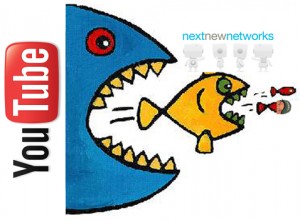
So I’m not privileged to any discussions between YouTube and Next New Networks, and know nothing more about the alleged acquisition than I’ve read here. While I have been aware of rumors of someone acquiring NNN for a couple months, I didn’t even seriously consider the possibility that Google/YouTube would buy it. So it was fresh news to me when I got a text from ZackScott today (he wanted to brag about his recent GoogleTV gift, and how he’s become a bigger sellout than me).
My thoughts on the potential of a deal. First, “Why It Makes Little Sense At First Glance”
I can only imagine some of the conversations between the right-coast, roight brained NNN gang and the left-coast, left-brained engineers. It could be like a toaster trying to talk to a boom box.
Why It Makes Great Sense
I think I sufficiently hedged this post so that I retain rights to say “I told you so” if this deal is a great success, and hires me… or if it flops insanely.
What do you think? Or don’t you care? See this is my problem… when amazing news like this breaks, nobody in my IRL circle cares. Folks at my client and in my family don’t give a rats ass, so I need to work it out here.
Is it animal cruelty to laugh at a bunch of cute ducklings getting blown across the cement by a gust of wind? Source: Unruly’s Viral Video Chart.
Advertisers on YouTube now have an option where they only pay when a viewer engages with the pre-roll ad. It’s a bold way to get digital marketers to move confidently into the medium since, like Google Paid Search, it’s more accountable. Here’s the YouTube blog post about this new format called “True View.”

Since most content is too short for the new option (similar to Hulu’s format, viewers get to pick a long preroll or several short ad interruptions), the more interesting of these two new offerings is the “instream” 5 & 15/30 format. You watch 5 seconds, and then you decide if you’ll continue watching the rest of the ad (15/30 seconds). That means creators/publishers will make no revenue on those who abandon. But the format will no doubt demand a higher premium (per click) for those who choose to engage.
This also means advertisers should do a better job of giving the consumer a REASON to continue. The first 5 seconds should certainly mention the brand (free exposure like the “reminder” effect of unclicked paid-search ads). But most advertisers who want deeper engagement or direct response will want to use those first 5 seconds to PITCH THE AD.
For instance, “find out why this kitten is crying” would compel me to finish the ad. Or “be one of the first to own what’s in this box” is a nice teaser. Eventually when the format is less novel, the “calls to continue” will need to be better.

I believe Business Insider is right in predicting that Google will give advertisers “love” or charge them less if they’re getting a better pull-through on these ads… similar to how strong creative text ads on Google are rewarded with better positions. Jason Kinkaid raises a good point on TechCrunch:
…given how different this is from what most consumers are used to, it may be a bit too early to gauge how well these ads are actually working — users may be skeptical of hitting the skip button at all because they’ve never seen it before.
It should be obvious that this is an additive option not a replacement of your traditional 15-30 second preroll. If it was my choice, I’d move to it quickly a) to learn, and b) to see if there’s a better ROI on them, c) to take advantage of the novelty factor. Then again, I’m biased. I’m making money from these. So frankly, I hope you buy whatever’s most expensive. But I hope you also get an ROI on it.
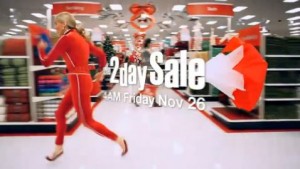
Target’s Black Friday campaign staring Maria Bamford spawned loads of “word of mouth,” and captured AdAge’s attention by ranking #2 on the AdAge Viral Chart with more than 1.5 million views in a week. Sure that’s still far below my definition of “viral video” (I’m thinking the new definition is 4 million views in a few days). But the campaign, by Portland, Oregon agency Wieden & Kennedy, clearly has become more than a 2010 footnote. Here’s Target Lady’s highlight reel, which culminates in the fantastic shot of her running through target wearing a parachute to slow her down.
Naturally Steve Hall (AdRants) hate’s it, but TV Critic Roger Catlin gave it a “an hail Target ad lady Maria” review. AgencySpy was most impressed with the Rocky IV tune. But the real surprise, to me, was when my wife said: “wait- look at this…everyone’s raving about it on Facebook.” According to ClickZ, some sponsored ads fueled that Facebook fire.
Click here to see YouTube’s Target collection, ranked by most-viewed.
Some of these spots are good enough to stop you from fast forwarding TiVo. Maria Bamford has a wonderfully crazy and self-deprecating style that makes even ME feel sane. She’s not new to Target — check out her subtle “Target” reference in this video from years ago (below). She’s funny in standup (effinfunny.com), but translates even better to web video and was a perfect fit for this wonderfully insane Target campaign.
I hope to see her back, since I think she’ll appeal to Target’s target customer. We’ll still need our “cool” target ads, but this is distinctive and fun, and a refreshing departure from me-two department store ads (wow we’ve got deals… zzzzz). I could honestly see the Target Lady pulling a mini Old Spice video-reply campaign with personalized videos… the mad rush for holidays is far from over, but there’s not likely time for a new campaign. Hey Wieden & Kennedy- if she’s answering questions I’d like to know how many cups of coffee she drinks a day and how many hours of sleep she gets. I’d also savour, like fine wine, some behind-the-scenes outtakes from the commercial shoot.
If you like Target Lady, write WK agency (contact information) or be sure to write Maria’s mom. Mothers need affirmation sometimes, and maybe she’ll let Maria out of the attic to reward her. Or heck, pick up a piece of no-soap made by her dad.

Renetto. Paul Robinette. Remember him? He makes about $55 a day from YouTube, and I once stalked him and shaved my head to assume his persona. He’s one of the guys behind one of the most interesting video website stats and mobile applications you’re bound to love and forget. It’s called MyU2B. See– I had to look at the website just to get that stupid name right.
The good news? If you’re an OCD creator or media buyer, than this is (and you can quote the guy who wrote the book on YouTube) “the crack cocaine of video statistics.” The bad news? The name is so damned forgettable I want to punch Paul Robinett in his branding boob. Half the reason I’m writing this post is so I can find his website searching the many alternative names my brain has given MyU2B: u2be, myu2be, ub40, u2b4, my2be u2be u2bme, and finally “renetto, youtube, stats, website, with, stupid, name.”
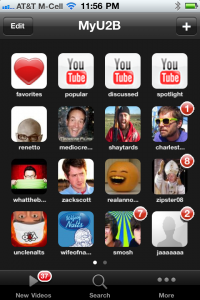
MyU2B is my indispensable iPhone YouTube viewing app because it’s incredibly easy to sort by my favorite creator’s (people, channels, accounts, profiles) most recent videos. This is a common but impossible task via the caveman-like primitive search functions on YouTube’s own mobile app, and I call that a “deal breaker” or “functional obsolescence” for any regular viewer. MyU2B tells me exactly how many videos my favorite person or channel has posted since I last checked them. It solved a problem most don’t yet know we have.
The app (free and $1.99) also allows me to “super subscribe” to select people (although I haven’t figured out how to delete people like the incorrect jaaaaaa). There are about 2-3 dozen people I don’t want to ever miss, and for that I prefer this app to using YouTube on a computer. On YouTube I’ve “oversubscribed” like many people, so I miss some fresh videos by my favorite peeps. It really sucks to not be current on some of my favorite creators or friends.
The MyU2B stats site, although new and somewhat buggy, is entirely different (yet shares the horrible name). It gives you some pretty decent estimates of how much money each channel/person makes on could make (per comments below) on YouTube, and even sorts estimated revenue by individual video. That’s badass, even if it’s assuming CPMs (revenue per view) that are impossibly inconsistent and volatile. It’s a cool tool just to track who’s getting views and comments… instead of the somewhat archaic method of tracking subscribers… like on VidStatsx. Vidstatsx is an equally crappy named but remarkably useful website, though the latter is a bit too focused on subscriptions (which is not nearly driver of daily views it once was). And tip from Zipster08, who I never miss (despite the mocked screen shot): allow MyU2B to load completely before searching for someone. (Zipster checks hourly). MyU2B doesn’t yet allow you to bookmark or link to a specific search string, but it does index more than 11,000 individual channels.
See below for an example… are they the potential estimates accurate? I don’t know. YouTube doesn’t give me reporting this precise, but I know for a fact that CPMs by individual videos for the same creator can vary from pennies to dollars — by individual video.
Since we YouTube Partners are all contractually obliged to conceal our revenue, it’s hard to know if it’s over or understating revenue/earnings. But feel free to comment (anonymously) if you want to share feedback on its precision! I’m glad it’s not accurate, because I don’t want people thinking about the money I earn from YouTube (it’s equally embarrassing whether it’s high, low or accurate).
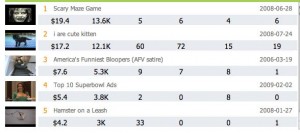
Finally, let’s help these useful resources with their branding. Anything, including the word “pizzle,” would be better.
Hard to criticize this lovely video featuring surprised passengers in Heathrow Airport being surprised by a cappella songs in every genre. Part of T-Mobile’s Life’s For Sharing campaign.
I just wish they’d partnered with or acknowledged Charlie Todd (author of Causing a Scene) because he kinda invented (or at least popularized) this type of video.
“Video advertising is still ‘in its diapers’… you gotta remember that most people don’t want to see ads” said eMarketer’s David Hallerman in a webcast last Thursday (October 21, 2010). eMarketer provided highlights from a report (“Video Advertisement Engagement: What Marketers Need to Know”) in the one-hour webinar, and slides are excerpted from that.
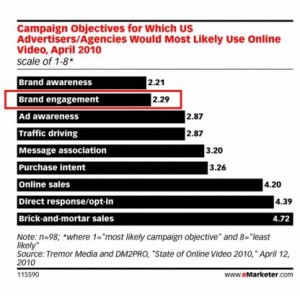
Hallerman says online-video is the most expensive form of digital advertising, and skews toward professional content not user-generated. He explores both the definitions and forms of engagement. Per the chart on the right, awareness is still the #1 goal of marketers followed closely by engagement (according to an April 2010 study by Tremor Media of 98 advertisers/agencies).
So what is engagement? Some say it’s paying attention, others refer to interactivity, and still others refer to what happens afterwards.
I’d prefer to focus on what Hallerman calls server based data (a view, start-rate, completion time, mouse-over, sharing) and not survey data (like “brand health” metrics like awareness or intent, reported by Insight Express or Dynamic Logic). However those “brand health” metrics can be vital to determining “intent to buy,” which is often not captured by server metrics (although some cookies provide advertisers data about purchases that occur long after a video view).
Engagement metrics include:
Context is also important… an auto-roll on gaming or entertainment site is not going to be as powerful as a self-directed and completed video on a shopping site. Hallerman reminds us that consumers value HD (above many other factors) and that quality (original versus repurposed) is vital, and that’s an important insight. During the Q&A Hallerman later acknowledged that some studies are showing that repurposed television commercials are faring better than once expected.
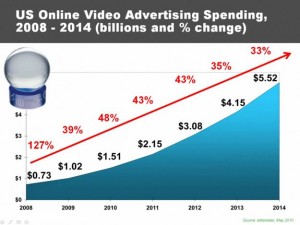
eMarketer projects continued growth of the medium as depicted above — reaching at least $5.5 billion by 2014. But when it comes to online-video ad views, all video sites aren’t created equally (comScore, Sept. 30, 2010). The report shows that “ads per viewer” on Hulu is more than seven times higher than Google/YouTube sites. See the rank of video-advertising properties, and Hulu tops followed by Brightcove and Tremor Media (both which serve ads on websites not exclusively devoted to video content). At 30 ads per viewer per month, it’s no wonder Hulu is considering cutting its monthly subscription in half.
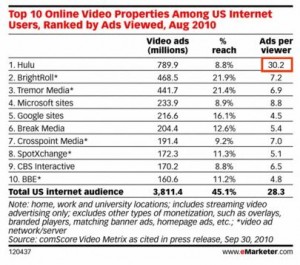
Time per month per viewer on YouTube is nearly twice that of Hulu, despite Hulu’s content being generally longer (22 minute shows versus 2-3 minute videos). Hallerman refers to Hulu’s experience as “lean back” because we allow the show “to wash over” us, whereas other sites (YouTube) require a more “lean forward” experience. Marketers, says Hallerman, are looking for what they know from broadcast advertising — pre or mid-rolls played “in stream” during a video’s view.
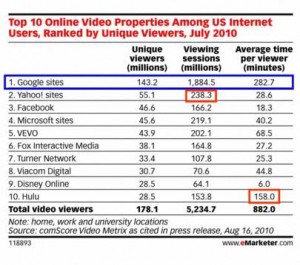
Marketers choose ad-networks to target online-video ads based on two factors: demographic or content. A beauty ad on Break.com, Hallerman explains, won’t likely get high engagement. As for viral?
“…You don’t just make something go viral,” Hallermans says. “It’s really a whole process that needs a blend of paid, owned and earned.” He provides the recent Old Spice example, which involved paid ads on television and the web, a microsite showing more content, and “earned” media where video answers responded to specific bloggers. He credits the paid ads were the “spark.”
Aside from viral or its own reason, here are what some marketers claim to have accomplished on YouTube. So one in five (20%) say their YouTube videos have driven sales via links. But recognize that the data are not saying that happens twenty percent of the time- it’s usually in the low single digits in my experience.
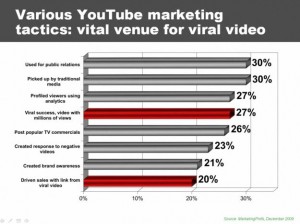
Branded content (where the marketing is not “heavy handed” and is “almost a bi-product”) is the most effective forms of marketing according to an October 2010 report by the CMO Council. Branded content tops more traditional online advertising models or even database-driven behavioral marketing. Video content, for instance, about dogs with dog-food product placement… may have a greater impact than dog-food ads alone. “Creating an experience,” Hallerman says, “is hard but important.” These can be tracked by brand-equity scores. He provides another example of a hair-care product that might show entertaining or educational fashion tips (focusing on benefits) rather than advertising about the product (features).
During the eMarketer webcast, EyeWonder shared “server side” data that show higher engagement rates for ads in the financial sector, with travel or electronics on the low side of engagements. EyeWonder showed a case study involving Gatorade’s G Series, which featured a 15-second ad that allows customers to see how the beverage helps before, during and after an athletic event. The click-thru rate was a tame .13%, but the a video completion rate was an impressive 62% across all of the impressions.
Hallerman was asked to comment on how to make a video more likely to be viral, but said if he had the answer he’d be working at an agency. Perhaps he just needs a copy of “Beyond Viral.” 🙂
There’s been a lively debate recently among online-video enthusiasts about Google/YouTube’s capacity to sell display advertising. Sales people need different skill sets selling paid-search (automated, measurable, bid-based) versus display advertising (which is less measurable and more like selling television or print). To understand the distinction, see Google’s video; this is something we’ve been exploring at WillVideoForFood since Google bought YouTube in 2007. While Google has deep relationships with top companies and industries, it has only recently put emphasis behind non-search advertising.
YouTube’s display team (a few dozen) is rather small, and most YouTube ads are sold via Google Adwords not the dedicated team. While the display team sometimes lands some comprehensive ad buys with advertising agencies and brands, most monetization on YouTube is marginalized. The CPMs (cost per thousand) are so disappointing to some creators and online-video studios that some (from Next New Network and Revision3 to TheStation) have begun to sell their own inventory, or partner with ad networks that can attract better monetization for their views. Increasingly YouTube has provided creators and intermediaries tools to sell their inventory directly.
That said, there was some encouraging news from Jonathon Rosenberg, Google’s SVP for product management. According to this eWeek piece titled “Google YouTube, Android Drive $3.5B in Ads.”
Google’s display ad business… operating at an annualized run-rate of $2.5 billion. That’s counting YouTube ads, and all non-text ads running on Google’s network and DoubleClick networks, Jonathan Rosenberg, Google’s senior vice president of product management, said on the Q3 earnings call. “You guys always ask me (referring to analysts)… where’s your next multi-billion dollar business after search,” Rosenberg said. “There’s your answer.”